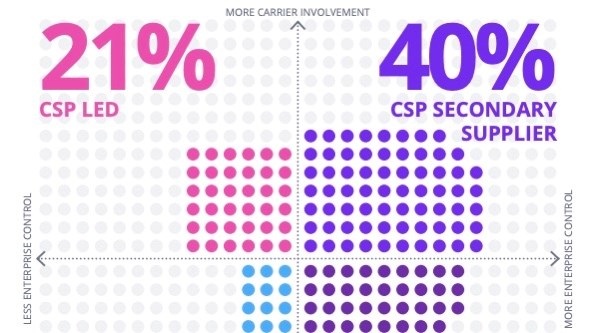
Omdia report slice
- CSPs are counting on 5G enterprise services for new revenue generation
- But CSPs are not dominating early 5G enterprise engagements – far from it, according to Omdia research
- Some early 5G enterprise deals have even cut out CSPs altogether
Communications service providers (CSPs) are pinning their hopes on driving 5G revenues from enterprise customers, but market insights from research house Omdia suggest they are in danger of missing their golden B2B 5G opportunity, potentially worth trillions of dollars during the coming decades, unless they revamp their go-to-market strategies.
A new report, titled Industries and enterprises are ready to reap the benefits of 5G and released today by digital business platform and cloud-native BSS specialist BearingPoint//Beyond in collaboration with Omdia, concludes that CSPs are missing out on playing the lead role in early 5G enterprise services deals, and are not being included at all in some.
That’s because the enterprises are looking for a broader package of services and technologies that includes, but is not limited to, 5G connectivity, while many CSPs are still focused on delivering 5G connectivity as an isolated service offering because they don’t have the partnership ecosystem in place to deliver a broader suite of applications and solutions.
The early evidence of what could be considered a significant set-back for 5G operators comes from Omdia’s Enterprise 5G Innovation Tracker, which has identified more than 300 5G-related contracts awarded by enterprises. Of these, only 21% were led by CSPs, while 32% were being led by an internal team within the enterprise. Some deals didn’t involve a CSP at all – the automotive sector has been identified as a vertical where the CSPs are being sidelined. Other projects are being led by a broad selection of companies, including systems integrators and vendors. So it’s currently quite a fragmented market.

Omdia and BearingPoint//Beyond 5G enterprise services report graph
“With 5G B2B, many enterprises are being the orchestrator of their own situations, which include 5G [connectivity] but don’t necessarily include [direct involvement from] CSPs,” says Dario Talmesio, Principal Analyst & Practice Leader, CSPs Europe, at Omdia.
He says the main challenge for CSPs is the way they think about their engagement with enterprises and that tey still believe they can offer everything the enterprises need. “At the moment the CSPs are focused on 5G as a connectivity bearer… they need to collaborate [with external partners] and be an ecosystem orchestrator,” adds Talmesio.
It’s not like there aren’t some positive examples, though. “It’s not a lost opportunity for all. We are seeing that some CSPs are better equiping themselves – for example, Verizon teaming up with AWS, Telefonica [forging partnerships] in the mining industry and there are others,” says the Omdia man.
But currently those are exceptions, not the rule, and for the CSPs the writing was already on the wall: Earlier this year, BearingPoint//Beyond highlighted research results that suggested CSPs were already falling short of enterprise user expectations about what telcos might be able to offer in a 5G world.
In the findings of that report, BearingPoint//Beyond CEO Angus Ward noted: “Businesses want to buy 5G, CSPs want to sell 5G. The problem is that CSPs want to just sell connectivity and standardized ‘connectivity plus infrastructure’ products, while businesses want to buy more sophisticated, complete solutions that better fit their needs and require the integration of multiple technologies from multiple player.”
And those businesses are expected to spend a lot. According to the forecasting team at Omdia, the 5G enterprise services market (comprising connectivity, hardware, solutions/applications) could be worth up to $13.2 trillion (yes, TRILLION!) during the next 15 years or so. That’s a lot of business to win, or miss out on.
“That’s looking far into the future but the opportunity to capitalize on this for the CSPs is now… or even two years ago… they need to focus on what enterprises want to achieve and [help them] achieve their goals,” says the analyst.
Talmesio notes that the manufacturing sector is expected to provide the greatest business opportunity, with the value of 5G services delivered to companies in that sector pegged by Omdia at $4.6 trillion between now and 2035.
Michal Harris, Head of Marketing at BearingPoint//Beyond, says the company has been tracking the B2B space for CSPs for some time and is certain that enterprise 5G is where the main revenue growth exists for CSPs, but “the report shows that if CSPs are to benefit from 5G enterprise opportunities, they need to make sure they don’t repeat the same mistakes that were made in 4G [and IoT and cloud]. It all needs to start with what enterprises want – the CSPs need to understand that better. The conversation is still all about technology but it needs to be about the business needs of the enterprises,” she stresses.
And is it a surprise that CSPs are not dominating the early 5G enterprise deals? “It is a disappointment but not a surprise. CSPs just need to step up to the role and move up the value chain and address customer problems,” says Harris.
“There are a lot of new technologies out there for enterprises to consider – there is AI, cloud and more, as well as 5G,” she notes: That’s a lot to consider for enterprises, which just want solutions that bring the most relevant technologies and services together, adds the BearingPoint//Beyond exec.
- Ray Le Maistre, Editorial Director, TelecomTV
We want to hear from you!
Take part in our 5G and Security survey and receive a free copy of the downloadable report ahead of general release.
Email Newsletters
Sign up to receive TelecomTV's top news and videos, plus exclusive subscriber-only content direct to your inbox.




